Usain Bolt: Running with primary display of maximum power under competitive conditions
Фотографии:
ˑ:
Professor, PhD, Honoured Coach of the RF I.N. Mironenko1
Associate Professor, PhD O.M. Mirzoev1,2
1 Russian State University of Physical Culture, Sport, Youth and Tourism (GTSOLIFK), Moscow
2 Moscow State Institute of Culture, Moscow.
Keywords: 100 m distance run, running speed, velocity components, length and frequency of strides, startle response time, correlation.
Introduction. The biological foundations of origin, genetic inheritance and optimal construction of the sports training process have long been the main components of continuous and successful performance of outstanding sprinter of the early XXI century, fastest man in the world in the 100 m dash - Usain Bolt (Jamaica). His main achievements were demonstrated in the last three Olympic cycles.
Undoubtedly, it is owing to the above-mentioned achievements that this outstanding Jamaican is in the focus of scientists’ attention. What are the components of the athlete’s speed of movement along the distance? How faster can one ever run? What abilities does Usain St. Leo Bolt, the discovery of the XXI century, possess?
Biotopology. Date and place of birth: August 21, 1986, Jamaica. Height: 196 сm. Weight: 86 kg. Quetelet index: 0.439 g/cm. Body mass index: 22.40 kg/m2. Leg length: ≈ 105 cm. Stride module: maximal – 2.83 m / 1.96 m = 1.46 rel.u.; average – 2.45 m / 1.96 m = 1.25 rel.u.
Research objective was to study the dynamics of kinematic parameters of technical skills of the world-record holder in the 100 m distance run and determine their individual informativeness.
Research methods. For the purpose of the study, we analyzed the velocity components of the running technique of leading sprinter of the world U. Bolt. We relied upon the results of the athlete’s competitive activity retrieved during the semifinal and final races of the official international competitions, 2008 through 2016.
The data were obtained in the following ways: - by analyzing the video captures of the running technique conducted according to M. Mirzoev; - using the IAAF study group materials [10]. The intra-individual statistical analysis of the data was carried out by means of the "Data Analysis" in Excel.
Research results. Normally, the kinematics of sprint is studied by means of the inter-individual analysis, which implies assessment and further comparison of the parameters in a group of athletes [2, 4, 5, 6, 7, 8, 9]. At the same time, G.G. Arzumanov [1] proved that informativeness of the individual and group kinematic parameters of the 100 m dash may differ (Table 1).
Table 1. Correlation of group and individual kinematic parameters with 100 m run results (G. G. Arzumanov [1]).
|
Kinematic parameters of running 100 m dash |
Correlation coefficient of group informativeness (n = 23) |
Correlation coefficient of individual informativeness |
||
|
sprinter A.S. |
sprinter B.M. |
sprinter V.P. |
||
|
Time of achievement of Vmax |
- 0.27 |
- 0.39 |
0.89 |
0.01 |
|
Retention time of Vmax |
0.14 |
- 0.26 |
0.25 |
0.13 |
|
Time of decrease of Vmax |
0.10 |
- 0.33 |
0.43 |
0.57 |
|
Maximum speed |
- 0.94 |
- 0.87 |
- 0.43 |
- 0.85 |
|
Speed of 80-100 m segment run |
- 0.81 |
- 0.81 |
- 0.60 |
0.52 |
|
Reaction time |
0.42 |
0.75 |
- 0.43 |
- 0.85 |
Proceeding from the experimental data of Table 1, we traced the kinematic patterns of U. Bolt in the 100 m distance run using the intra-individual statistical analysis tool.
Table 2 lists different kinematic characteristics of U. Bolt’s technical skills while running the 100 m dash, obtained during his performances at the world championships (WCh) and Olympics Games (OG) [4, 5, 6]. The athlete’s sports results range between 9.58 (current world record) and 10.05 seconds.
Table 2. Kinematic parameters of U. Bolt’s technical skills in 100 m distance run (n = 13).
|
N |
Competitions, year, Round |
Parameters |
Reaction time, s |
|||||
|
Mark, s |
V, m/s |
n |
l, m |
f, st/s |
М, r.u. |
|||
|
1 |
OG, 2016. Final |
9.81 |
10.19 |
41.35 |
2.42 |
4.22 |
1.23 |
0.155 |
|
2 |
OG, 2016. Semi-Final |
9.86 |
10.14 |
41.5 |
2.41 |
4.21 |
1.23 |
0.143 |
|
3 |
WCh, 2015. Final |
9.79 |
10.21 |
41.3 |
2.42 |
4.22 |
1.23 |
0.159 |
|
4 |
WCh, 2015. Semi-Final |
9.96 |
10.04 |
41.5 |
2.41 |
4.16 |
1.23 |
0.148 |
|
5 |
WCh, 2013. Final |
9.77 |
10.24 |
41.2 |
2.43 |
4.22 |
1.24 |
0.163 |
|
6 |
WCh, 2013. Semi-Final |
9.92 |
10.08 |
41.0 |
2.44 |
4.13 |
1.25 |
0.173 |
|
7 |
OG, 2012. Final |
9.63 |
10.38 |
41.0 |
2.44 |
4.26 |
1.24 |
0.165 |
|
8 |
OG, 2012. Semi-Final |
9.87 |
10.13 |
40.1 |
2.49 |
4.06 |
1.27 |
0.180 |
|
9 |
WCh, 2011. Semi-Final |
10.05 |
9.95 |
40.5 |
2.47 |
4.03 |
1.26 |
0.164 |
|
10 |
WCh, 2009. Final WR |
9.58 |
10.44 |
41.0 |
2.44 |
4.28 |
1.24 |
0.146 |
|
11 |
WCh, 2009. Semi-Final |
9.89 |
10.11 |
40.0 |
2.50 |
4.04 |
1.28 |
0.135 |
|
12 |
OG, 2008. Final |
9.69 |
10.32 |
41.1 |
2.43 |
4.24 |
1.24 |
0.165 |
|
13 |
OG, 2008. Semi-Final |
9.85 |
10.15 |
40.0 |
2.50 |
4.06 |
1.28 |
0.161 |
|
1 |
Means |
9.82 |
10.18 |
40.88 |
2.45 |
4.16 |
1.25 |
0.158 |
|
2 |
Standard error |
0.04 |
0.04 |
0.15 |
0.01 |
0.02 |
0.005 |
0.003 |
|
3 |
Medians |
9.85 |
10.15 |
41.00 |
2.44 |
4.21 |
1.24 |
0.161 |
|
4 |
SD |
0.13 |
0.14 |
0.55 |
0.03 |
0.09 |
0.02 |
0.01 |
|
5 |
Variability, % |
1.3 |
1.3 |
1.3 |
1.4 |
2.1 |
1.4 |
7.9 |
|
6 |
Excess |
- 0.09 |
- 0.07 |
- 0.94 |
- 0.92 |
- 1.51 |
- 0.92 |
- 0.26 |
|
7 |
Аsymmetry |
- 0.31 |
0.39 |
- 0.73 |
0.76 |
- 0.42 |
0.76 |
- 0.23 |
Note to Table 2. v – average running speed, n – number of strides, l – length of strides; f – frequency of strides; М – average stride module (stride length/body length ratio). In 2011, during the final race at the World Championship in Daegu (Korea), U. Bolt was disqualified for the false start.
The athlete was 22 years old when he set the world record. The overall average length of the stride - 2.50 m; it was achieved twice - in 2008 and 2009. It should be noted that most of the presented parameters are characterized by the low variability from 1.3 to 2.1%, except for the startle response time (7.9%). This indicates the high-degree automatization of motor actions while running with maximum anaerobic power.
The intra-individual correlation analysis of the parameters of the running technique of the world record-breaker U. Bolt in the 100 m distance run (n = 13), which were registered during the competitions, revealed that the frequency of strides, one of the velocity components, was a statistically significant index for 1% of significance level with a high negative coefficient (- 0.79) of correlation with the result. As for other components - the length of strides and startle response time, they were insignificantly (p≥0.05) low (Table 3).
Table 3. Intra-individual correlation of parameters of running technique of world record-breaker U. Bolt in 100 m run (n=13).
|
N |
Parameters |
Mark |
Velocity components |
|
|
Average length of strides |
Average frequency of strides |
|||
|
1 |
Average length of strides |
0.25 |
-- |
-- |
|
2 |
Average frequency of strides |
- 0.79 |
- 0.79 |
-- |
|
3 |
Reaction time |
0.04 |
0.17 |
- 0.13 |
Note to Table 3. p=0.01 at r≥0.71.
Figures 1 and 2 illustrate the multidirectional trends in the mean values of length and frequency of strides that become noticeable with improvement of the results (maximal anaerobic power). This shows that, to accelerate, U. Bolt increases the frequency of his strides by increasing their length.
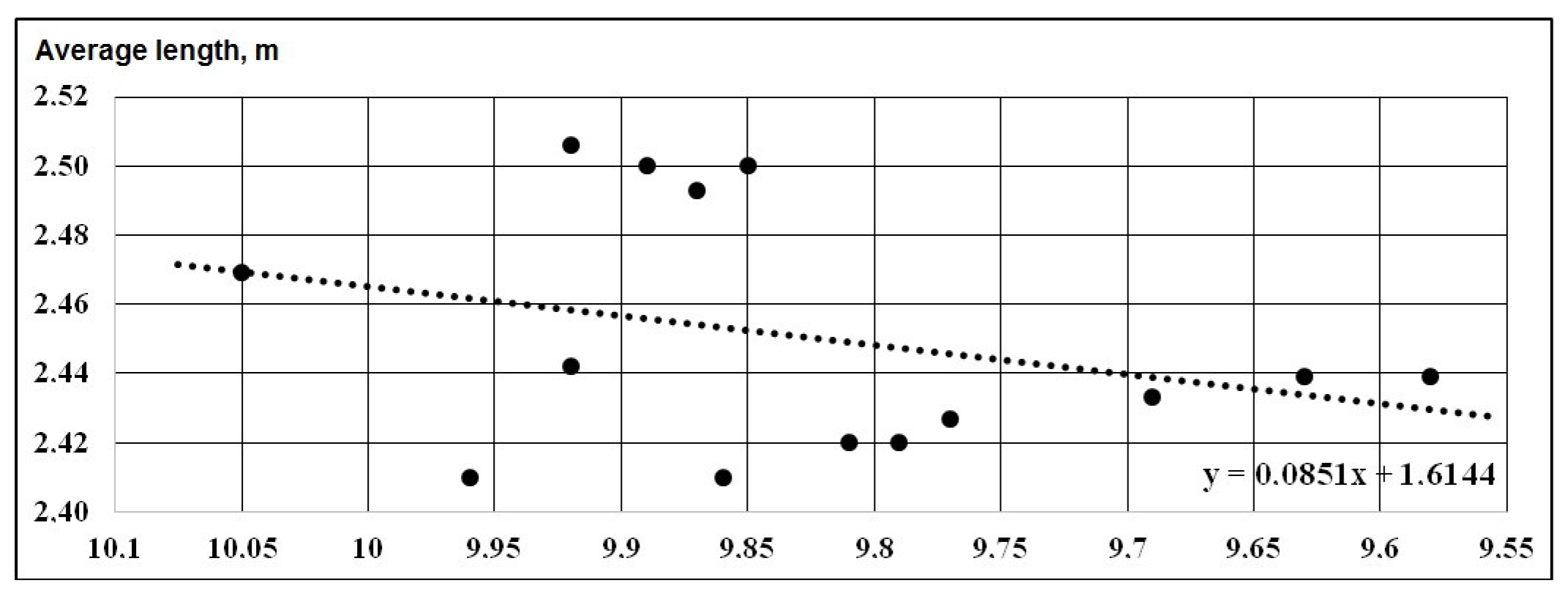
Figure 1. Correlation of average length of strides and sports result of U. Bolt in 100 m dash
To understand the nature of changes in the kinematic parameters of technical skills, we compared the indices obtained during the athlete’s performance in the semifinal and final races (Table 4). It is to be emphasized that running at high speed in the semifinal race is very important, since it is the semifinal race result that determines whether the athlete is qualified for the world championship and the Olympic Games, where the medal event is held indeed.
The data obtained in the two rounds determine the peculiarities of the athlete’s running technique in the finals. It should be noted here that the sprinter’s performance in the final race with maximum speed, as opposed to the semifinal one, improves mainly due to the frequency of strides (Tables 5, 6, Figures 3 and 4).
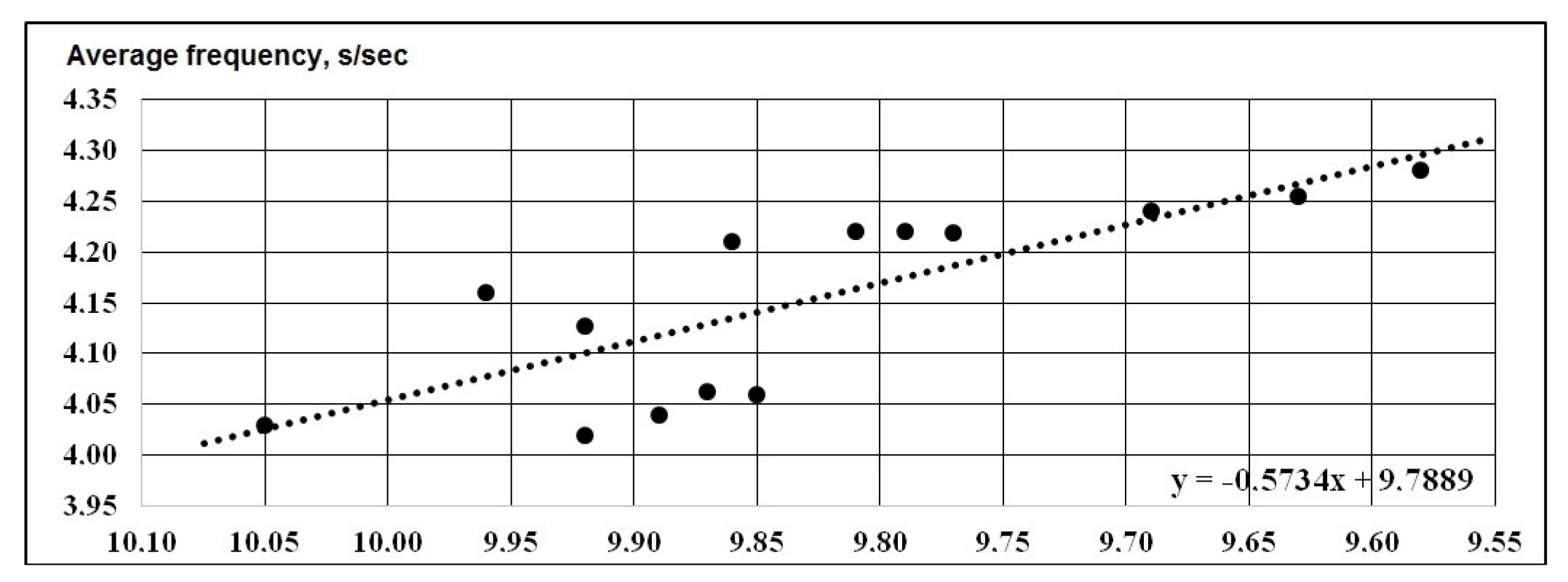
Figure 2. Correlation of average frequency of strides and sports result of U. Bolt in 100 m dash.
Table 4. Comparison of different parameters of running technique of U. Bolt in 100 m run in two rounds during world championships and Olympic Games.
|
N |
Round |
Parameters |
|||||
|
Mark, S |
V, m/s. |
n |
l, m |
f, st/s |
Reaction time, s |
||
|
1 |
Finals (n = 6) |
9.71 |
10.30 |
41.16 |
2.43 |
4.24 |
0.159 |
|
2 |
Semi-Finals (n = 7) |
9.91 |
10.09 |
40.65 |
2.46 |
4.10 |
0.158 |
|
3 |
Difference |
- 0.20 |
0.21 |
0.50 |
- 0.03 |
0.14 |
0.001 |
Table 5. Kinematic parameters of U. Bolt’s technical skills in 100 m finals during world championships and Olympic Games (n=6).
|
N |
Parameters |
Parameters |
|||||
|
Mark, s |
V, m/s |
n |
L, m |
f, st/s |
Reaction time, s |
||
|
1 |
Means |
9.71 |
10.30 |
41.16 |
2.43 |
4.24 |
0.159 |
|
2 |
Standard error |
0.04 |
0.04 |
0.06 |
0.00 |
0.01 |
0.003 |
|
3 |
Medians |
9.73 |
10.28 |
41.15 |
2.43 |
4.23 |
0.161 |
|
4 |
SD |
0.09 |
0.10 |
0.15 |
0.01 |
0.02 |
0.007 |
|
5 |
Variability, % |
1.0 |
1.0 |
0.4 |
0.4 |
0.6 |
4.7 |
|
6 |
Excess |
0.01 |
0.01 |
0.02 |
0.0001 |
0.0006 |
0.0001 |
|
7 |
Аsymmetry |
- 1.77 |
- 1.61 |
- 1.86 |
- 2.26 |
- 0.13 |
0.93 |
|
8 |
Maximum |
9.58 |
10.19 |
41.00 |
2.42 |
4.22 |
0.15 |
|
9 |
Minimum |
9.81 |
10.44 |
41.35 |
2.44 |
4.28 |
0.17 |
The comparison of different parameters of U. Bolt’s running technique in the semi-finals and finals of the iconic athletic competitions revealed that the sports result, and consequently the speed of movement along the distance, was higher in the final race by 0.20 m/s, since both races were held on the same date, and the athlete’s physical and technical condition was almost unchanged. Yet, U. Bolt, who surpasses his rivals in skills and qualities, has a certain tactical setup during the semi-finals, which implies the display of near-maximum capacities, i.e. covering the distance (especially in the finish line - 80-100 m) not at full capacity. This explains the difference in the kinematic parameters of running technique in the semi-final and final races.
Table 6. Intra-individual correlation of U. Bolt’s kinematic parameters in 100 m run during world championships and Olympic Games finals (n=6).
|
N |
Parameters |
Mark |
Velocity components |
|
|
Average length of strides |
Average frequency of strides |
|||
|
1 |
Average length of strides |
- 0,.96 |
-- |
-- |
|
2 |
Average frequency of strides |
- 0.97 |
0.89 |
-- |
|
3 |
Reaction time |
0.27 |
- 0.05 |
- 0.47 |
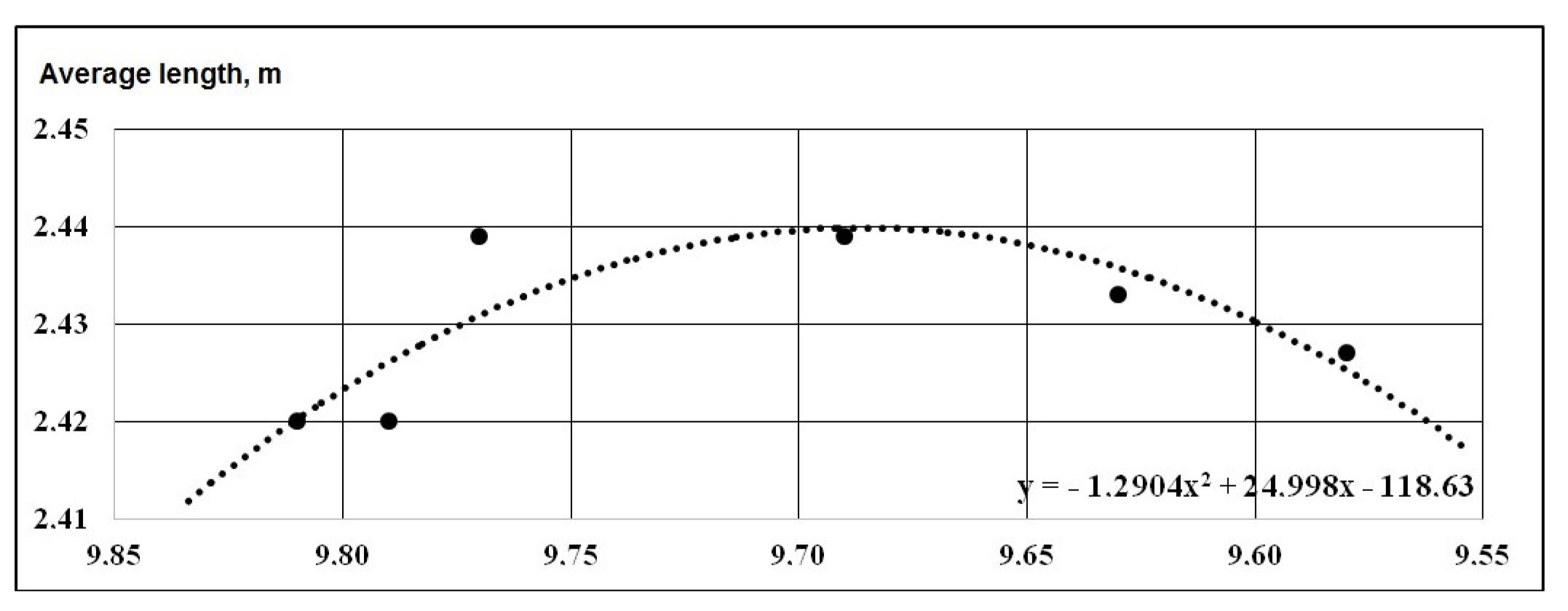
Figure 3. Dependence of average length of strides on sports result of U. Bolt in 100 m finals (n = 6).
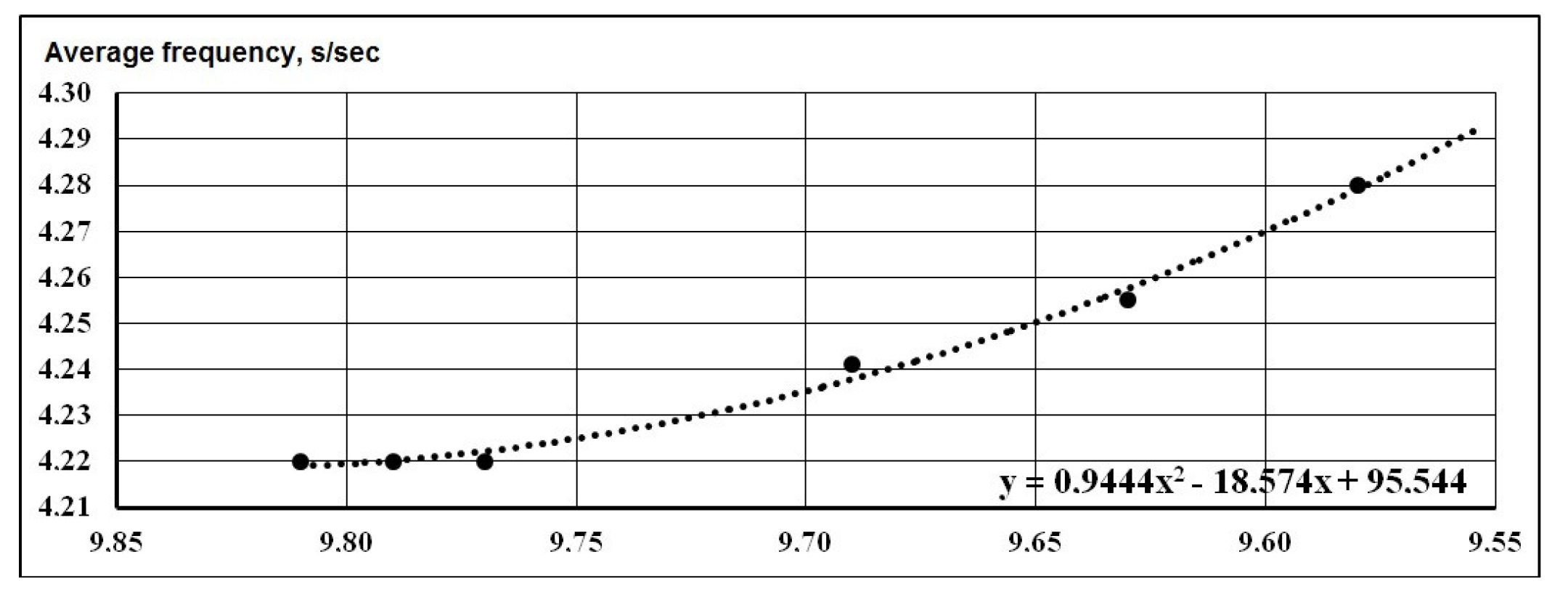
Figure 4. Dependence of average frequency of strides on sports result of U. Bolt in 100 m finals (n=6).
So, in the finals, the average length of strides decreases by 3 cm, and, as a result, the number of strides on the distance increases. Against this background, the average frequency of strides in the main race increases by 0.14 s/sec, which, in the end, improves the sports result by 0.20 sec. Thus, the sprinter has an advantage over himself by approximately 2 m.
It is worth noting that the variability of strides in the finals is significantly smaller (1.7%) than in the semi-finals. This indicates a more strictly programmed technique of motor actions while running with maximum intensity.
During the 100 m finals at the 2008 Beijing Olympics, the world record-holder demonstrated the peak speed of 12.2 m/s (43.9 km/h) and average length of stride of 2.60 m. To achieve this result he covered the distance of 41.1 strides [10].
In the finals of the 2009 Berlin World Championship, U. Bolt set the new world record in the 100 m distance - 9.58 s (10.44 m/s, or 37.66 km/h). The 60-80 m part of distance was covered in 1.61 s, and thus the athlete demonstrated the highest running speed - 12.42 m/s (44.72 km/h).
Results and discussion of. If a man is taken out of the general biological context, by the example of U. Bolt, it can be shown that the enhancement (improvement) of man’s speed abilities is not only due to the body dimensions and, in particular, the leg length, but also due to the increase in one of the velocity components - the frequency of strides. However, the frequency of strides cannot increase endlessly. It follows herefrom that it is necessary to mention the other component – the length of strides, as well as their proportional balance. With the maximum frequency of strides, the contact time is about 80 ms, and the total time of a stride is 249 ms. Flight time is 169 ms. K = tflight / tcontact = 2.11.
The intra-individual correlation analysis shows (see Table 2) that the 100 m dash result demonstrated by U. Bolt largely depends on the average frequency of strides, which has the high negative coefficient of correlation equaling 0.83 for 1% significance level. As is known, the frequency of strides largely depends on the level of special power fitness of the flexor muscles of the thigh and lower leg, as well as foot plantar flexors. Against this background, we should note the low (0.36) and insignificant correlation of the average length of strides with sports result. The interdependence of the length and frequency of strides is inverted and reaches the high level (r = - 0.79, at p≤0.01). That is, with increasing frequency of strides U. Bolt reduces their length proportionally. At the average frequency of strides (4.05 s/sec), their average length equals 2.50 m. The increase in the average frequency of strides to 4.25 s/sec leads to the reduction in the length of strides to 2.43±0.01 m. We should note the low variability of the mean absolute and relative (module of average length of strides relative to leg length = 2.34 m) length of strides (V%=1.42), which testifies to the stable stride amplitude and lack of significant progress in special weight-lifting exercises for the leg extensor muscles. When the 100 m dash results range within 0.50 sec, the length of strides reduces by 6-8 cm only (see Table 1 and Fig. 4), which amounts to 2.84±0.4%. Within the same range, the average frequency of strides increased by 6.28%, i.e. twofold or even more.
All this indicates that in his motor set the Jamaican sprinter is focused on the kinematic structure of the first strides and on their dynamics. Most often, this does not give him any advantages in the first third of the distance (0-30 m), but enables him, as a tall man with long legs, to more harmoniously accelerate.
Conclusion. What is the main component of the world champion’s technique that enables him to run fast? In a greater degree, it is his leg length. During the maximum intensity run, this parameter is more conservative and is rather associated with the length of the athlete’s lower extremities than their strength. Although a lot of hard work has been done on the improvement of special force of the leg extensor muscles, which determines the length of strides, their average length has been ranging within 2 cm in the finals and 9 cm in the semi-finals for 9 years now. Anthropometry of the lower extremities and the amplitude structure of strides ensure their stability. Could U. Bolt run any faster? As proved by the proposed analysis of the athlete’s technical skills, an increase of the Jamaican sprinter’s sports results depends on the increase of the frequency of strides. This is due to the improvement of special power and ability to fast tense – relax the leg flexor muscles.
References
- Arzumanov G.G. Vliyanie trenirovochnykh rezhimov na izmenenie pokazatel'nykh strukturnykh komponentov tekhniki bega i spetsialnoy rabotosposobnosti sprinterov. Avtoref. dis. kand. ped. nauk [Influence of training modes on variations of parameter structural components of running technique and special working capacity of sprinters. PhD Diss. abstr.]. Moscow: GTsOLIFK publ., 1982, 24 p.
- Guseynov F., Mironenko I., Travin Y., Tyupa V., Tyurin Y. Utomlenie i tekhnika bega [Fatigue and running technique]. Legkaya atletika, 1982, no. 9, pp. 8-9, 19.
- Zatsiorskiy V.M. Fizicheskie kachestva sportsmena. Osnovy teorii i metodiki vospitaniya [Athlete's physical qualities. Fundamentals of theory and methodology of education]. Moscow: Sovetskiy sport publ., 2009. 200 p.
- Mirzoev O.M., Maslakov V.M. Sorevnovatel'naya deyatel'nost' sil'neyshikh legkoatletov Rossii, Evropy i mira. Sprinterskiy i bar'erny beg (sorevnovatel'naya deyatel'nost' po itogam 20130) [Competitive performance of the strongest athletes of Russia, Europe and world. Sprint and hurdles (final competitive performance rates for 2013)]. Voronezh, Nauchnaya kniga publ., no. 19. 2014, pp. 37-49.
- Mirzoev O.M., Maslakov V.M. Tekhnicheskoe i takticheskoe masterstvo legkoatletov na Olimpiyskikh igrakh: Beg na korotkie distantsii. Bar'erny beg (k itogam XXX Olimpiyskim igram). Uchebno-metodicheskoe posobie [Technical and tactical skills of track and field athletes at the Olympics: Sprint. Hurdles (final rates for the XXX Olympic Games). Teaching aid]. Voronezh: Nauchnaya kniga publ., 2012, pp. 30-31.
- Mirzoev O.M. Fenomen Usejna Bolta. Klyuchevye momenty kinematicheskikh pokazateley tekhnicheskogo masterstva v bege na 100 m [Usain Bolt phenomenon. Key points of kinematic parameters of technical skills in 100 m run]. Teoriya i praktika fiz. kultury, 2015, no. 4. pp. 66-71.
- Mironenko I.N. Vliyanie antropologicheskikh faktorov na sportivnye dostizheniya v legkoatleticheskikh pryzhkakh i korotkom sprinte [Anthropological factors and their effect on performance in athletic jumps and sprint]. Teoriya i metodika legkoy atletiki: innovatsii v fizicheskom vospitanii, sportivnoy trenirovke i ozdorovitel'noy fizicheskoy kul'ture. Sbornik nauchnykh trudov [Theory and Methods of track and field athletics: Innovations in Physical Education, Athletic Training and Recreational Physical Culture]. Smolensk: SSAPCST publ., 2005, pp. 117-121.
- Mironenko I.N., Zhukov I.L., Zhukova E.M. Kriterii otsenki tekhnicheskogo masterstva begunov [Criteria for evaluation of runners' technical skills]. Tezisy dokladov Vsesoyuz. nauch.-prakt. konf. "Problemy kompleksnogo kontrolya v sporte vysshikh dostizheniy" [Proc. All-Union res.-pract. conf. "Complex control issues in elite sports"], Moscow, 1983, p. 26.
- Tyupa V.V., Guseynov F.A., Mironenko I.N. Izmenenie tekhniki sprinterskogo bega pod vliyaniem utomleniya [Changes in sprint run technique under fatigue]. Teoriya i praktika fiz. kultury, 1989, no. 2, pp. 33-36.
- Home of World Athletic. International Association of Athletic Federations. Available at: http://www.iaaf.org. (Accessed 01-22.08.2016)
- https://sport.mail.ru/news/athletics /26955562 (Accessed 31.08.2016)
Corresponding author: imir5@mail.ru; prorector@mail.ru
Abstract
The phenomenal sports results and achievements of Jamaican sprinter, multiple world record-holder, world champion and Olympic champion U. Bolt will attract the attention of specialists in different spheres for many years to come, as this athlete is alone in his ability to effectively and consistently display maximum anaerobic power in extreme conditions for a long time. A multi-year research on the kinematic parameters of the athlete’s technical skills in the 100 m distance run, conducted during various competitions, as presented in the current paper, has enabled to detect the peculiarities of organization of biomechanical characteristics, as well as find the ways to improve the efficiency of motor actions carried out with maximum power.

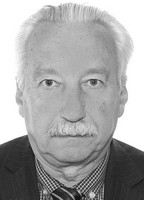

 Журнал "THEORY AND PRACTICE
Журнал "THEORY AND PRACTICE